BCO5501: Research Report on Business Process Management and Issues
VerifiedAdded on 2023/01/17
|13
|4585
|67
Report
AI Summary
This research report critically analyzes Business Process Management (BPM) within a technological context, drawing from the 15th International Conference on BPM. The report begins with an introduction to BPR and BPM, defining key concepts and emphasizing the importance of BPM in re-engineering business processes. It explores the concept of elasticity in BPM, particularly in relation to cloud computing and resource management. The study further examines the issues organizations face during BPM implementation, such as technological risks, cost implications, security concerns, and data migration challenges. Finally, it discusses strategies for successful BPM execution, including training and the adoption of new technologies. The report provides an in-depth analysis of the current state of BPM and its future direction.
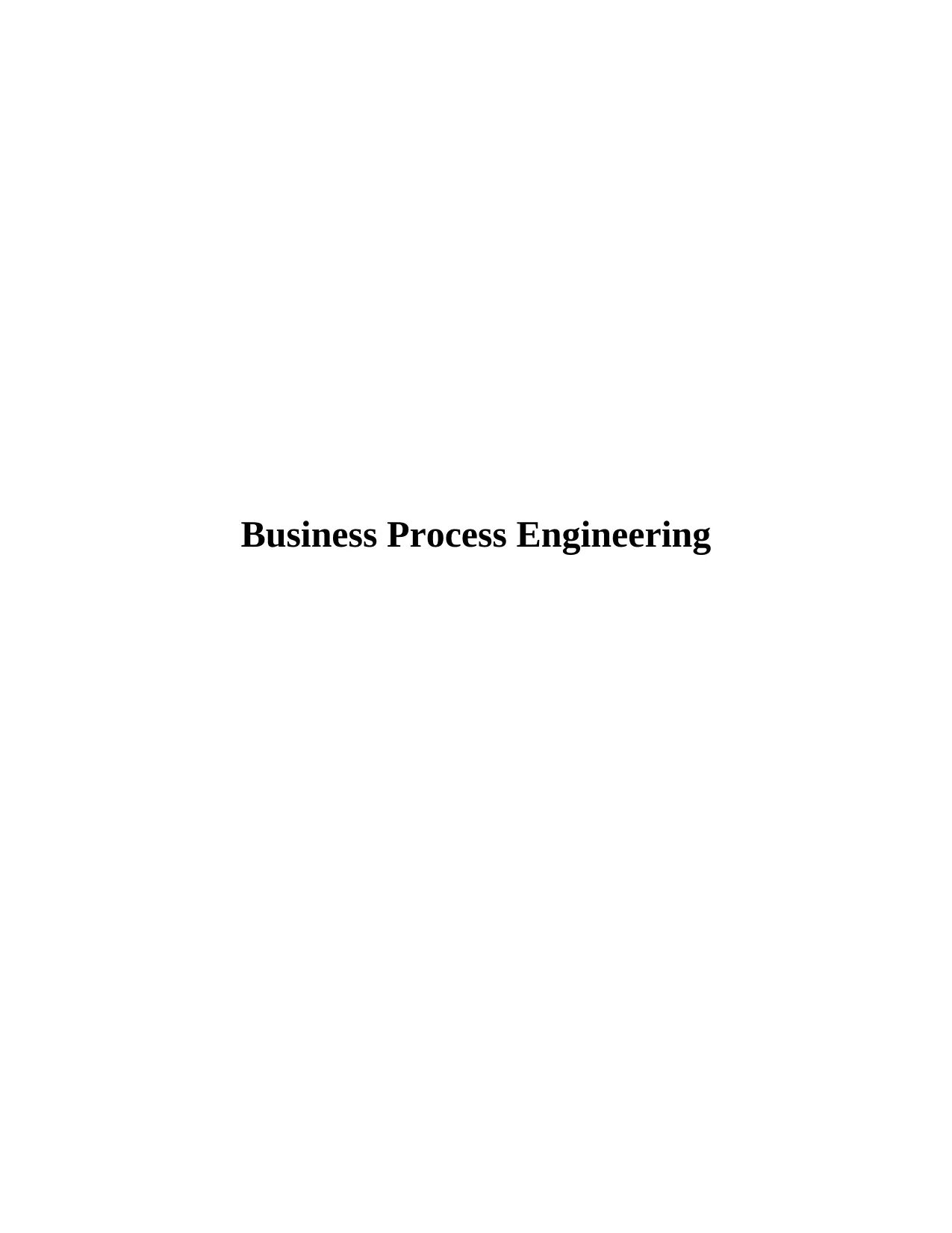
Business Process Engineering
Paraphrase This Document
Need a fresh take? Get an instant paraphrase of this document with our AI Paraphraser
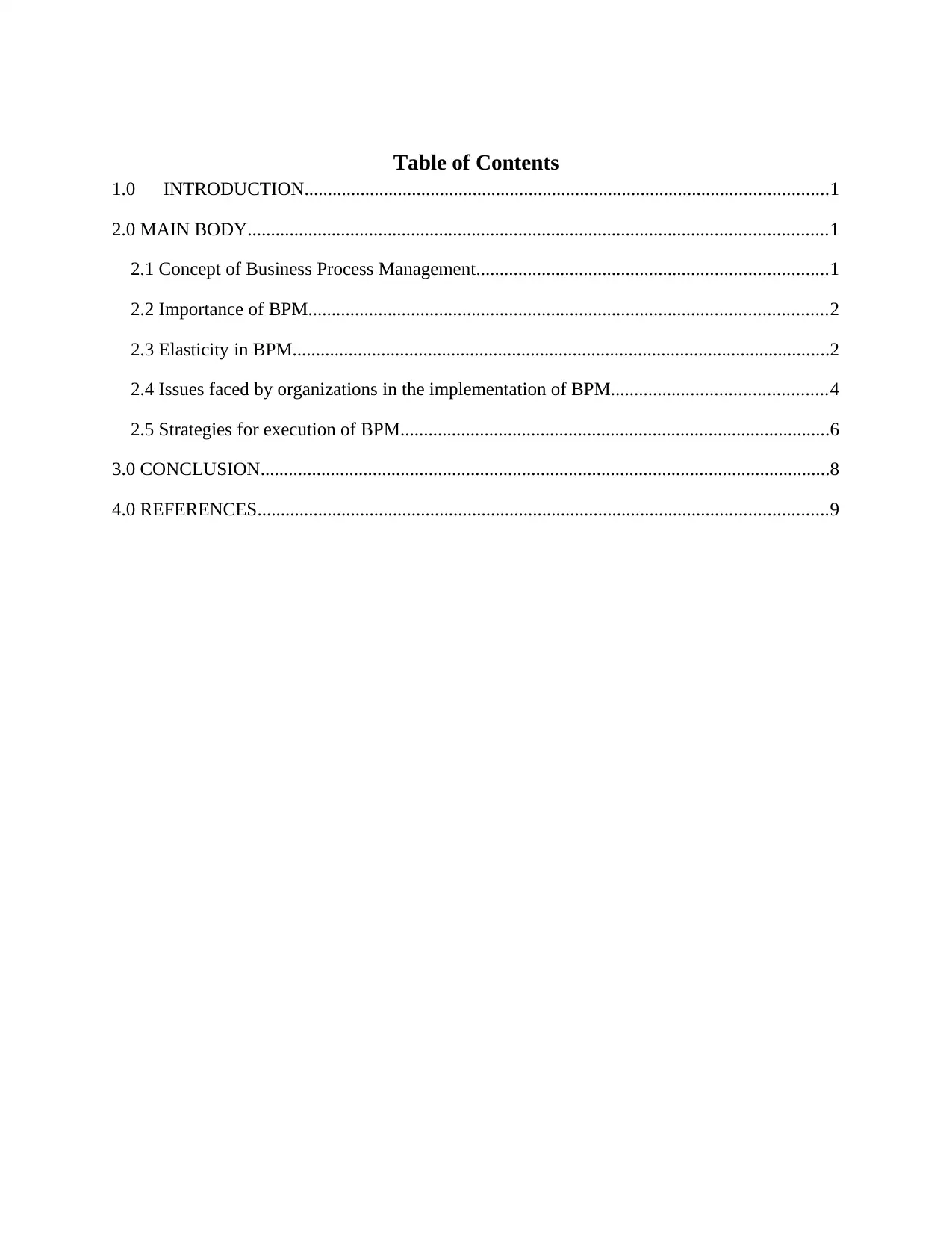
Table of Contents
1.0 INTRODUCTION................................................................................................................1
2.0 MAIN BODY............................................................................................................................1
2.1 Concept of Business Process Management...........................................................................1
2.2 Importance of BPM...............................................................................................................2
2.3 Elasticity in BPM...................................................................................................................2
2.4 Issues faced by organizations in the implementation of BPM..............................................4
2.5 Strategies for execution of BPM............................................................................................6
3.0 CONCLUSION..........................................................................................................................8
4.0 REFERENCES..........................................................................................................................9
1.0 INTRODUCTION................................................................................................................1
2.0 MAIN BODY............................................................................................................................1
2.1 Concept of Business Process Management...........................................................................1
2.2 Importance of BPM...............................................................................................................2
2.3 Elasticity in BPM...................................................................................................................2
2.4 Issues faced by organizations in the implementation of BPM..............................................4
2.5 Strategies for execution of BPM............................................................................................6
3.0 CONCLUSION..........................................................................................................................8
4.0 REFERENCES..........................................................................................................................9

Topic- Business Process Management (BPM) in the technological environment and issues faced
in re-engineering
1.0 INTRODUCTION
Business Process Engineering (BPR) is a business management strategy which is used to
analyze as well as the design of workflows and business processes inside the organization
(Weske, 2012; Jeston, 2014). The main aim of the BPR is to reduce the overall cost of the
enterprise and possesses redundancies. In this context, the current study is based on the
preparation of a research report on Business Process Management (BPM). For this purpose, the
specific paper has been used from the range of 14th to 16th International Conference on BPM.
Here, 15th International Conference track has been selected for the critical analysis of BPM.
Here, importance, the elasticity of BPM and strategies for implementation of BPM has been
critically evaluated with literature.
2.0 MAIN BODY
2.1 Concept of Business Process Management
According to Jeston (2014), BPM is a procedure or discipline in operations management
which is used to re-engineer the process and technologies of the organization. BPM is the
approach in which people use various methods to identify, analyze and improve the business
processes to be competitive in the current advanced environment (Dumas, La Rosa, Mendling
and Reijers, 2013). Moreover, Trkman (2010) stated that it is not necessary that BPM merely
adopted in technological fields; however, different sectors like education, construction, retail,
manufacturing etc. demand for the re-engineering because of time demands for the change. In
this context, BPM is used by the companies on an ongoing basis for the business process
improvements to reduce the chaos within the collective workflows which eliminates the ad hoc
workflow management (Trkman, 2010). In this manner, BPM is adopted by several
organizations such as Wal-Mart, Dell to improve performance and productivity. For instance,
Wal-Mart adopted a new process to improve the purchasing system. Here, the company
implemented a Radio Frequency Identification (RFID) chips which help in the automatic
purchasing process and saves a lot of clerical efforts, cost and inefficiencies of the firm (Kosasi,
Saragih and Kom, 2014).
1
in re-engineering
1.0 INTRODUCTION
Business Process Engineering (BPR) is a business management strategy which is used to
analyze as well as the design of workflows and business processes inside the organization
(Weske, 2012; Jeston, 2014). The main aim of the BPR is to reduce the overall cost of the
enterprise and possesses redundancies. In this context, the current study is based on the
preparation of a research report on Business Process Management (BPM). For this purpose, the
specific paper has been used from the range of 14th to 16th International Conference on BPM.
Here, 15th International Conference track has been selected for the critical analysis of BPM.
Here, importance, the elasticity of BPM and strategies for implementation of BPM has been
critically evaluated with literature.
2.0 MAIN BODY
2.1 Concept of Business Process Management
According to Jeston (2014), BPM is a procedure or discipline in operations management
which is used to re-engineer the process and technologies of the organization. BPM is the
approach in which people use various methods to identify, analyze and improve the business
processes to be competitive in the current advanced environment (Dumas, La Rosa, Mendling
and Reijers, 2013). Moreover, Trkman (2010) stated that it is not necessary that BPM merely
adopted in technological fields; however, different sectors like education, construction, retail,
manufacturing etc. demand for the re-engineering because of time demands for the change. In
this context, BPM is used by the companies on an ongoing basis for the business process
improvements to reduce the chaos within the collective workflows which eliminates the ad hoc
workflow management (Trkman, 2010). In this manner, BPM is adopted by several
organizations such as Wal-Mart, Dell to improve performance and productivity. For instance,
Wal-Mart adopted a new process to improve the purchasing system. Here, the company
implemented a Radio Frequency Identification (RFID) chips which help in the automatic
purchasing process and saves a lot of clerical efforts, cost and inefficiencies of the firm (Kosasi,
Saragih and Kom, 2014).
1
⊘ This is a preview!⊘
Do you want full access?
Subscribe today to unlock all pages.

Trusted by 1+ million students worldwide

2.2 Importance of BPM
Jeston (2014) stated that BPM is an innovative approach which is essential to remold the
business process so that profitability as well as quality of work improves. Furthermore, well
established BPM helps to reduce waste, cost and save time which further supports to produce
quality products and services. However, Weske (2012) argued that BPM is essential in business
processes but it is not an easy task for the management because changes in procedures demands
for skilled labor force which again creates a cost for the firm. On the contrary, Chang (2016)
mentioned that training regarding new processes supports to maintain collaboration between new
approaches and workers so that effective outcomes are achieved. Besides this, Rosinosky et al.
(2017) notified that BPM is significantly required but it is not a one-time activity; here, leaders
needed to manage end-to-end business processes continue to introduce the new market trends
and opportunities. Further, BPM improves the efficiency and support for employee succession
planning (Trkman, 2010). Thus, it shows that BPM is essential for the organizations as well as
workforce because it has extensive support to improve the efficiency which further saves the
time and resources of the organizations. Also, it creates a continuous development environment
within the firm.
2.3 Elasticity in BPM
Schulte et al. (2015) stated that elastic BPM focuses on the infrastructural challenges by
using elastic cloud resources. Furthermore, elastic BPM system involves the work on scheduling,
decentralized coordination, resource allocation etc. for flexible processes. Similary, Rosinosky et
al. (2017) asserted that emphasizes is given on multitenancy functionalities through cloud
elasticity in BPM. However, Pathirage, Perera, Kumara and Weerawarana (2011) mentioned that
multitenant BPMs includes the processes with meta information as per the required resources
and further need to add the data in the BPM schema. Additionally, it needs to alter the BPM
system which does not have a purpose of resource allocation scheduling methods. Apart from
this, Mohamed et al. (2015, p.49) identified that cloud computing approach is getting great
importance in Information Technologies (IT); however, a dynamic or automatic method is used
to manage cloud resources. Furthermore, a flexible approach possesses the characteristics as a
formal model, generic controller, flexible strategies etc. Thus, it reflects that elasticity in BPM
required to manage the cloud resources which uses an automatic approach. Further, it does not
focus on resource allocation scheduling methods.
2
Jeston (2014) stated that BPM is an innovative approach which is essential to remold the
business process so that profitability as well as quality of work improves. Furthermore, well
established BPM helps to reduce waste, cost and save time which further supports to produce
quality products and services. However, Weske (2012) argued that BPM is essential in business
processes but it is not an easy task for the management because changes in procedures demands
for skilled labor force which again creates a cost for the firm. On the contrary, Chang (2016)
mentioned that training regarding new processes supports to maintain collaboration between new
approaches and workers so that effective outcomes are achieved. Besides this, Rosinosky et al.
(2017) notified that BPM is significantly required but it is not a one-time activity; here, leaders
needed to manage end-to-end business processes continue to introduce the new market trends
and opportunities. Further, BPM improves the efficiency and support for employee succession
planning (Trkman, 2010). Thus, it shows that BPM is essential for the organizations as well as
workforce because it has extensive support to improve the efficiency which further saves the
time and resources of the organizations. Also, it creates a continuous development environment
within the firm.
2.3 Elasticity in BPM
Schulte et al. (2015) stated that elastic BPM focuses on the infrastructural challenges by
using elastic cloud resources. Furthermore, elastic BPM system involves the work on scheduling,
decentralized coordination, resource allocation etc. for flexible processes. Similary, Rosinosky et
al. (2017) asserted that emphasizes is given on multitenancy functionalities through cloud
elasticity in BPM. However, Pathirage, Perera, Kumara and Weerawarana (2011) mentioned that
multitenant BPMs includes the processes with meta information as per the required resources
and further need to add the data in the BPM schema. Additionally, it needs to alter the BPM
system which does not have a purpose of resource allocation scheduling methods. Apart from
this, Mohamed et al. (2015, p.49) identified that cloud computing approach is getting great
importance in Information Technologies (IT); however, a dynamic or automatic method is used
to manage cloud resources. Furthermore, a flexible approach possesses the characteristics as a
formal model, generic controller, flexible strategies etc. Thus, it reflects that elasticity in BPM
required to manage the cloud resources which uses an automatic approach. Further, it does not
focus on resource allocation scheduling methods.
2
Paraphrase This Document
Need a fresh take? Get an instant paraphrase of this document with our AI Paraphraser
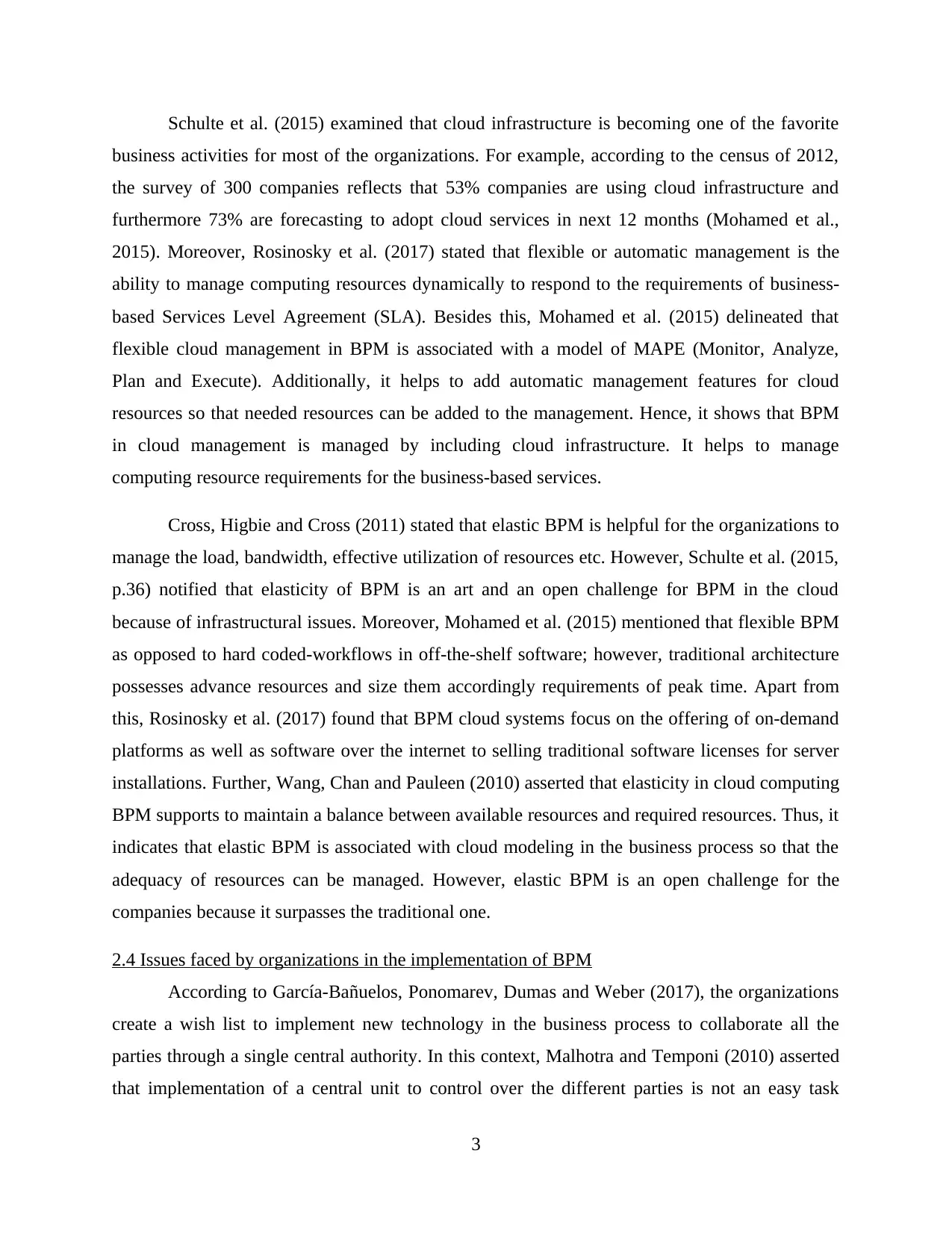
Schulte et al. (2015) examined that cloud infrastructure is becoming one of the favorite
business activities for most of the organizations. For example, according to the census of 2012,
the survey of 300 companies reflects that 53% companies are using cloud infrastructure and
furthermore 73% are forecasting to adopt cloud services in next 12 months (Mohamed et al.,
2015). Moreover, Rosinosky et al. (2017) stated that flexible or automatic management is the
ability to manage computing resources dynamically to respond to the requirements of business-
based Services Level Agreement (SLA). Besides this, Mohamed et al. (2015) delineated that
flexible cloud management in BPM is associated with a model of MAPE (Monitor, Analyze,
Plan and Execute). Additionally, it helps to add automatic management features for cloud
resources so that needed resources can be added to the management. Hence, it shows that BPM
in cloud management is managed by including cloud infrastructure. It helps to manage
computing resource requirements for the business-based services.
Cross, Higbie and Cross (2011) stated that elastic BPM is helpful for the organizations to
manage the load, bandwidth, effective utilization of resources etc. However, Schulte et al. (2015,
p.36) notified that elasticity of BPM is an art and an open challenge for BPM in the cloud
because of infrastructural issues. Moreover, Mohamed et al. (2015) mentioned that flexible BPM
as opposed to hard coded-workflows in off-the-shelf software; however, traditional architecture
possesses advance resources and size them accordingly requirements of peak time. Apart from
this, Rosinosky et al. (2017) found that BPM cloud systems focus on the offering of on-demand
platforms as well as software over the internet to selling traditional software licenses for server
installations. Further, Wang, Chan and Pauleen (2010) asserted that elasticity in cloud computing
BPM supports to maintain a balance between available resources and required resources. Thus, it
indicates that elastic BPM is associated with cloud modeling in the business process so that the
adequacy of resources can be managed. However, elastic BPM is an open challenge for the
companies because it surpasses the traditional one.
2.4 Issues faced by organizations in the implementation of BPM
According to García-Bañuelos, Ponomarev, Dumas and Weber (2017), the organizations
create a wish list to implement new technology in the business process to collaborate all the
parties through a single central authority. In this context, Malhotra and Temponi (2010) asserted
that implementation of a central unit to control over the different parties is not an easy task
3
business activities for most of the organizations. For example, according to the census of 2012,
the survey of 300 companies reflects that 53% companies are using cloud infrastructure and
furthermore 73% are forecasting to adopt cloud services in next 12 months (Mohamed et al.,
2015). Moreover, Rosinosky et al. (2017) stated that flexible or automatic management is the
ability to manage computing resources dynamically to respond to the requirements of business-
based Services Level Agreement (SLA). Besides this, Mohamed et al. (2015) delineated that
flexible cloud management in BPM is associated with a model of MAPE (Monitor, Analyze,
Plan and Execute). Additionally, it helps to add automatic management features for cloud
resources so that needed resources can be added to the management. Hence, it shows that BPM
in cloud management is managed by including cloud infrastructure. It helps to manage
computing resource requirements for the business-based services.
Cross, Higbie and Cross (2011) stated that elastic BPM is helpful for the organizations to
manage the load, bandwidth, effective utilization of resources etc. However, Schulte et al. (2015,
p.36) notified that elasticity of BPM is an art and an open challenge for BPM in the cloud
because of infrastructural issues. Moreover, Mohamed et al. (2015) mentioned that flexible BPM
as opposed to hard coded-workflows in off-the-shelf software; however, traditional architecture
possesses advance resources and size them accordingly requirements of peak time. Apart from
this, Rosinosky et al. (2017) found that BPM cloud systems focus on the offering of on-demand
platforms as well as software over the internet to selling traditional software licenses for server
installations. Further, Wang, Chan and Pauleen (2010) asserted that elasticity in cloud computing
BPM supports to maintain a balance between available resources and required resources. Thus, it
indicates that elastic BPM is associated with cloud modeling in the business process so that the
adequacy of resources can be managed. However, elastic BPM is an open challenge for the
companies because it surpasses the traditional one.
2.4 Issues faced by organizations in the implementation of BPM
According to García-Bañuelos, Ponomarev, Dumas and Weber (2017), the organizations
create a wish list to implement new technology in the business process to collaborate all the
parties through a single central authority. In this context, Malhotra and Temponi (2010) asserted
that implementation of a central unit to control over the different parties is not an easy task
3
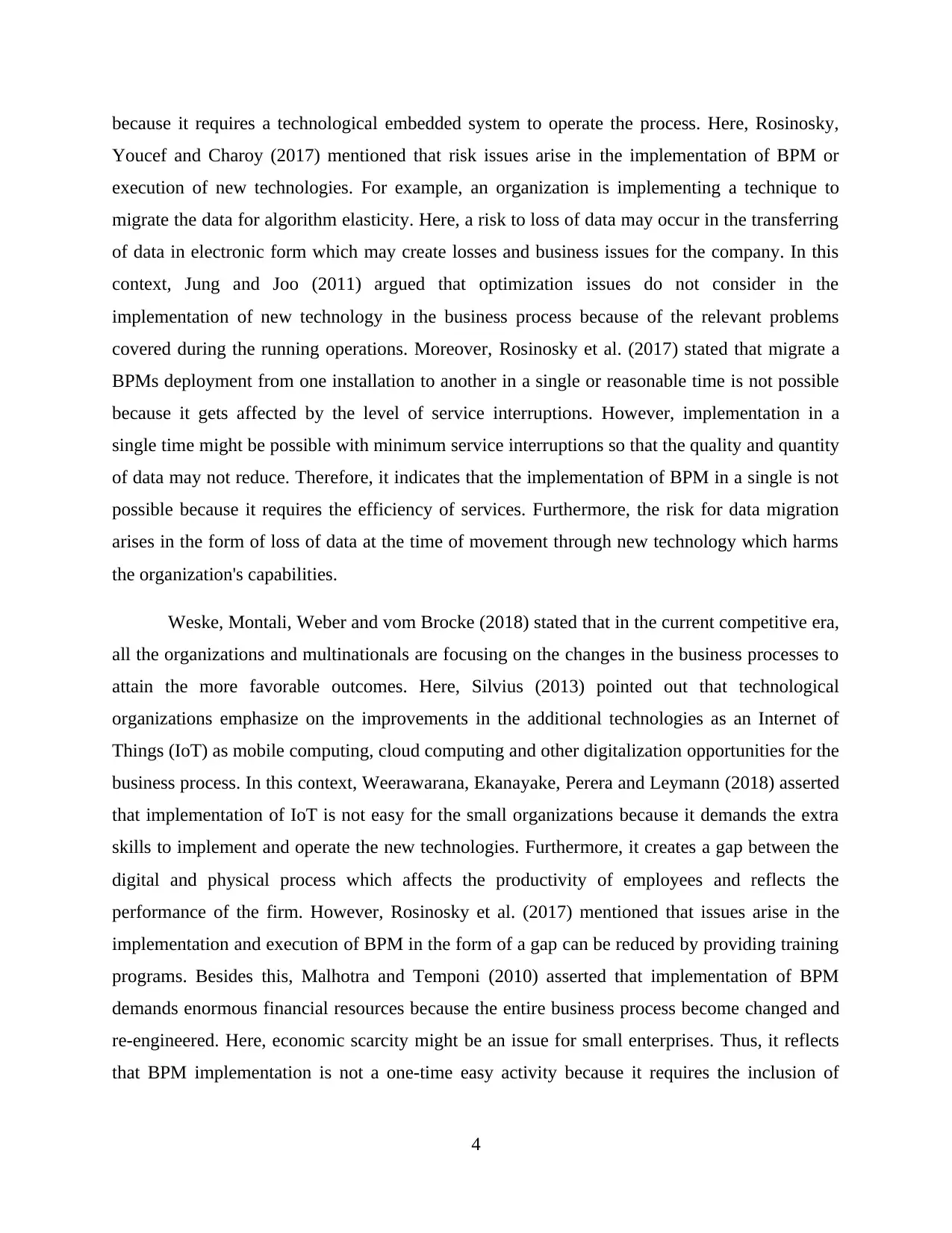
because it requires a technological embedded system to operate the process. Here, Rosinosky,
Youcef and Charoy (2017) mentioned that risk issues arise in the implementation of BPM or
execution of new technologies. For example, an organization is implementing a technique to
migrate the data for algorithm elasticity. Here, a risk to loss of data may occur in the transferring
of data in electronic form which may create losses and business issues for the company. In this
context, Jung and Joo (2011) argued that optimization issues do not consider in the
implementation of new technology in the business process because of the relevant problems
covered during the running operations. Moreover, Rosinosky et al. (2017) stated that migrate a
BPMs deployment from one installation to another in a single or reasonable time is not possible
because it gets affected by the level of service interruptions. However, implementation in a
single time might be possible with minimum service interruptions so that the quality and quantity
of data may not reduce. Therefore, it indicates that the implementation of BPM in a single is not
possible because it requires the efficiency of services. Furthermore, the risk for data migration
arises in the form of loss of data at the time of movement through new technology which harms
the organization's capabilities.
Weske, Montali, Weber and vom Brocke (2018) stated that in the current competitive era,
all the organizations and multinationals are focusing on the changes in the business processes to
attain the more favorable outcomes. Here, Silvius (2013) pointed out that technological
organizations emphasize on the improvements in the additional technologies as an Internet of
Things (IoT) as mobile computing, cloud computing and other digitalization opportunities for the
business process. In this context, Weerawarana, Ekanayake, Perera and Leymann (2018) asserted
that implementation of IoT is not easy for the small organizations because it demands the extra
skills to implement and operate the new technologies. Furthermore, it creates a gap between the
digital and physical process which affects the productivity of employees and reflects the
performance of the firm. However, Rosinosky et al. (2017) mentioned that issues arise in the
implementation and execution of BPM in the form of a gap can be reduced by providing training
programs. Besides this, Malhotra and Temponi (2010) asserted that implementation of BPM
demands enormous financial resources because the entire business process become changed and
re-engineered. Here, economic scarcity might be an issue for small enterprises. Thus, it reflects
that BPM implementation is not a one-time easy activity because it requires the inclusion of
4
Youcef and Charoy (2017) mentioned that risk issues arise in the implementation of BPM or
execution of new technologies. For example, an organization is implementing a technique to
migrate the data for algorithm elasticity. Here, a risk to loss of data may occur in the transferring
of data in electronic form which may create losses and business issues for the company. In this
context, Jung and Joo (2011) argued that optimization issues do not consider in the
implementation of new technology in the business process because of the relevant problems
covered during the running operations. Moreover, Rosinosky et al. (2017) stated that migrate a
BPMs deployment from one installation to another in a single or reasonable time is not possible
because it gets affected by the level of service interruptions. However, implementation in a
single time might be possible with minimum service interruptions so that the quality and quantity
of data may not reduce. Therefore, it indicates that the implementation of BPM in a single is not
possible because it requires the efficiency of services. Furthermore, the risk for data migration
arises in the form of loss of data at the time of movement through new technology which harms
the organization's capabilities.
Weske, Montali, Weber and vom Brocke (2018) stated that in the current competitive era,
all the organizations and multinationals are focusing on the changes in the business processes to
attain the more favorable outcomes. Here, Silvius (2013) pointed out that technological
organizations emphasize on the improvements in the additional technologies as an Internet of
Things (IoT) as mobile computing, cloud computing and other digitalization opportunities for the
business process. In this context, Weerawarana, Ekanayake, Perera and Leymann (2018) asserted
that implementation of IoT is not easy for the small organizations because it demands the extra
skills to implement and operate the new technologies. Furthermore, it creates a gap between the
digital and physical process which affects the productivity of employees and reflects the
performance of the firm. However, Rosinosky et al. (2017) mentioned that issues arise in the
implementation and execution of BPM in the form of a gap can be reduced by providing training
programs. Besides this, Malhotra and Temponi (2010) asserted that implementation of BPM
demands enormous financial resources because the entire business process become changed and
re-engineered. Here, economic scarcity might be an issue for small enterprises. Thus, it reflects
that BPM implementation is not a one-time easy activity because it requires the inclusion of
4
⊘ This is a preview!⊘
Do you want full access?
Subscribe today to unlock all pages.

Trusted by 1+ million students worldwide
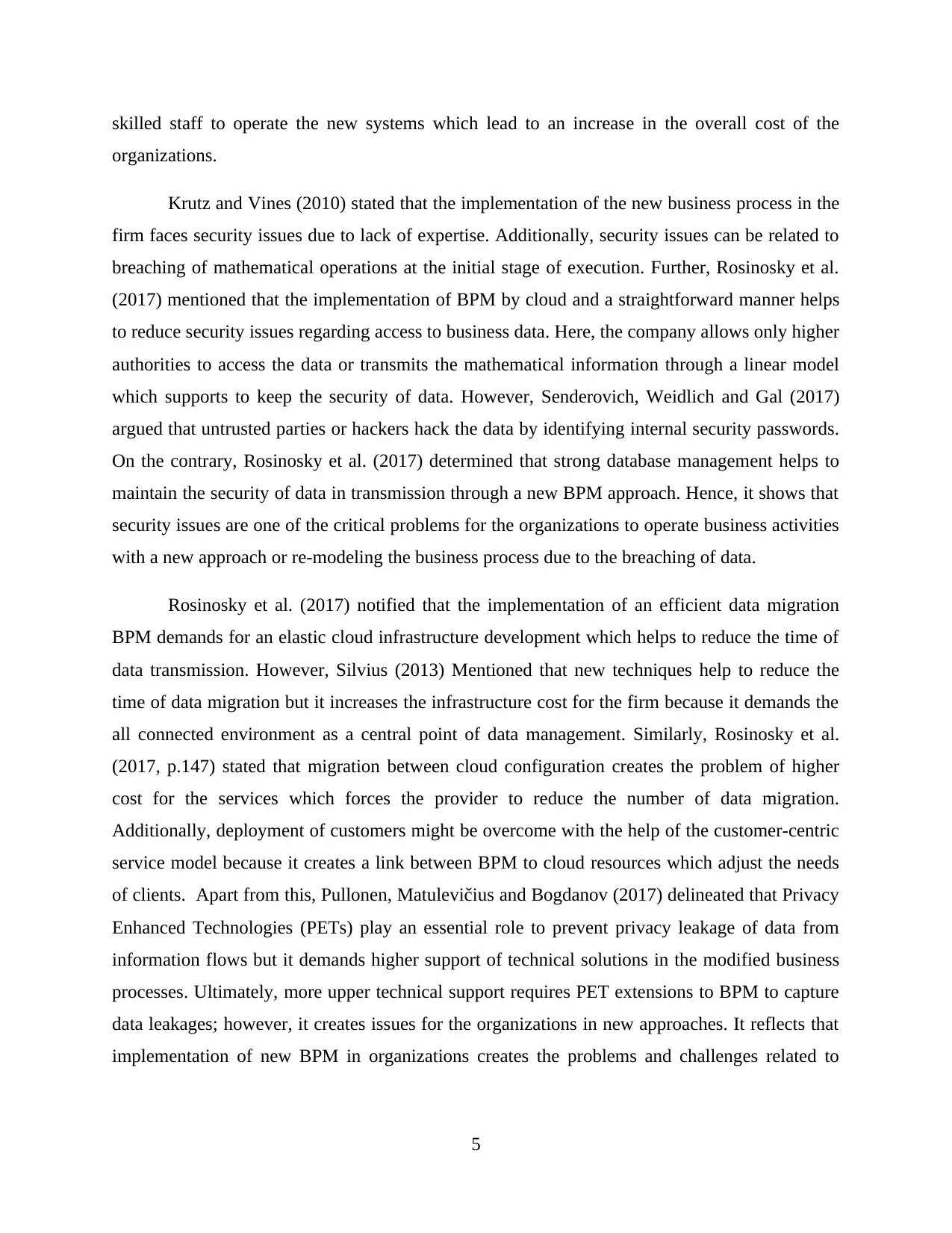
skilled staff to operate the new systems which lead to an increase in the overall cost of the
organizations.
Krutz and Vines (2010) stated that the implementation of the new business process in the
firm faces security issues due to lack of expertise. Additionally, security issues can be related to
breaching of mathematical operations at the initial stage of execution. Further, Rosinosky et al.
(2017) mentioned that the implementation of BPM by cloud and a straightforward manner helps
to reduce security issues regarding access to business data. Here, the company allows only higher
authorities to access the data or transmits the mathematical information through a linear model
which supports to keep the security of data. However, Senderovich, Weidlich and Gal (2017)
argued that untrusted parties or hackers hack the data by identifying internal security passwords.
On the contrary, Rosinosky et al. (2017) determined that strong database management helps to
maintain the security of data in transmission through a new BPM approach. Hence, it shows that
security issues are one of the critical problems for the organizations to operate business activities
with a new approach or re-modeling the business process due to the breaching of data.
Rosinosky et al. (2017) notified that the implementation of an efficient data migration
BPM demands for an elastic cloud infrastructure development which helps to reduce the time of
data transmission. However, Silvius (2013) Mentioned that new techniques help to reduce the
time of data migration but it increases the infrastructure cost for the firm because it demands the
all connected environment as a central point of data management. Similarly, Rosinosky et al.
(2017, p.147) stated that migration between cloud configuration creates the problem of higher
cost for the services which forces the provider to reduce the number of data migration.
Additionally, deployment of customers might be overcome with the help of the customer-centric
service model because it creates a link between BPM to cloud resources which adjust the needs
of clients. Apart from this, Pullonen, Matulevičius and Bogdanov (2017) delineated that Privacy
Enhanced Technologies (PETs) play an essential role to prevent privacy leakage of data from
information flows but it demands higher support of technical solutions in the modified business
processes. Ultimately, more upper technical support requires PET extensions to BPM to capture
data leakages; however, it creates issues for the organizations in new approaches. It reflects that
implementation of new BPM in organizations creates the problems and challenges related to
5
organizations.
Krutz and Vines (2010) stated that the implementation of the new business process in the
firm faces security issues due to lack of expertise. Additionally, security issues can be related to
breaching of mathematical operations at the initial stage of execution. Further, Rosinosky et al.
(2017) mentioned that the implementation of BPM by cloud and a straightforward manner helps
to reduce security issues regarding access to business data. Here, the company allows only higher
authorities to access the data or transmits the mathematical information through a linear model
which supports to keep the security of data. However, Senderovich, Weidlich and Gal (2017)
argued that untrusted parties or hackers hack the data by identifying internal security passwords.
On the contrary, Rosinosky et al. (2017) determined that strong database management helps to
maintain the security of data in transmission through a new BPM approach. Hence, it shows that
security issues are one of the critical problems for the organizations to operate business activities
with a new approach or re-modeling the business process due to the breaching of data.
Rosinosky et al. (2017) notified that the implementation of an efficient data migration
BPM demands for an elastic cloud infrastructure development which helps to reduce the time of
data transmission. However, Silvius (2013) Mentioned that new techniques help to reduce the
time of data migration but it increases the infrastructure cost for the firm because it demands the
all connected environment as a central point of data management. Similarly, Rosinosky et al.
(2017, p.147) stated that migration between cloud configuration creates the problem of higher
cost for the services which forces the provider to reduce the number of data migration.
Additionally, deployment of customers might be overcome with the help of the customer-centric
service model because it creates a link between BPM to cloud resources which adjust the needs
of clients. Apart from this, Pullonen, Matulevičius and Bogdanov (2017) delineated that Privacy
Enhanced Technologies (PETs) play an essential role to prevent privacy leakage of data from
information flows but it demands higher support of technical solutions in the modified business
processes. Ultimately, more upper technical support requires PET extensions to BPM to capture
data leakages; however, it creates issues for the organizations in new approaches. It reflects that
implementation of new BPM in organizations creates the problems and challenges related to
5
Paraphrase This Document
Need a fresh take? Get an instant paraphrase of this document with our AI Paraphraser
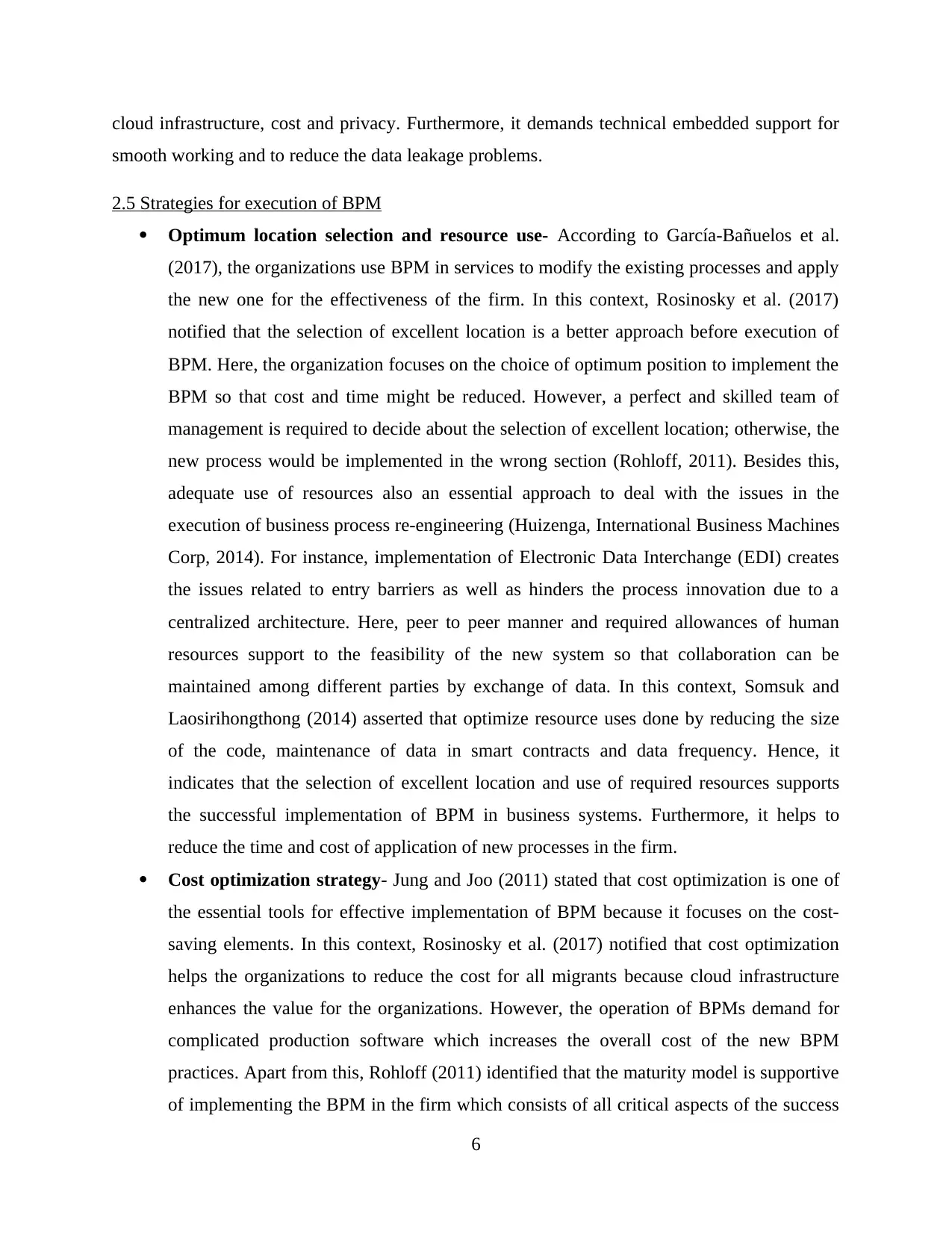
cloud infrastructure, cost and privacy. Furthermore, it demands technical embedded support for
smooth working and to reduce the data leakage problems.
2.5 Strategies for execution of BPM
Optimum location selection and resource use- According to García-Bañuelos et al.
(2017), the organizations use BPM in services to modify the existing processes and apply
the new one for the effectiveness of the firm. In this context, Rosinosky et al. (2017)
notified that the selection of excellent location is a better approach before execution of
BPM. Here, the organization focuses on the choice of optimum position to implement the
BPM so that cost and time might be reduced. However, a perfect and skilled team of
management is required to decide about the selection of excellent location; otherwise, the
new process would be implemented in the wrong section (Rohloff, 2011). Besides this,
adequate use of resources also an essential approach to deal with the issues in the
execution of business process re-engineering (Huizenga, International Business Machines
Corp, 2014). For instance, implementation of Electronic Data Interchange (EDI) creates
the issues related to entry barriers as well as hinders the process innovation due to a
centralized architecture. Here, peer to peer manner and required allowances of human
resources support to the feasibility of the new system so that collaboration can be
maintained among different parties by exchange of data. In this context, Somsuk and
Laosirihongthong (2014) asserted that optimize resource uses done by reducing the size
of the code, maintenance of data in smart contracts and data frequency. Hence, it
indicates that the selection of excellent location and use of required resources supports
the successful implementation of BPM in business systems. Furthermore, it helps to
reduce the time and cost of application of new processes in the firm.
Cost optimization strategy- Jung and Joo (2011) stated that cost optimization is one of
the essential tools for effective implementation of BPM because it focuses on the cost-
saving elements. In this context, Rosinosky et al. (2017) notified that cost optimization
helps the organizations to reduce the cost for all migrants because cloud infrastructure
enhances the value for the organizations. However, the operation of BPMs demand for
complicated production software which increases the overall cost of the new BPM
practices. Apart from this, Rohloff (2011) identified that the maturity model is supportive
of implementing the BPM in the firm which consists of all critical aspects of the success
6
smooth working and to reduce the data leakage problems.
2.5 Strategies for execution of BPM
Optimum location selection and resource use- According to García-Bañuelos et al.
(2017), the organizations use BPM in services to modify the existing processes and apply
the new one for the effectiveness of the firm. In this context, Rosinosky et al. (2017)
notified that the selection of excellent location is a better approach before execution of
BPM. Here, the organization focuses on the choice of optimum position to implement the
BPM so that cost and time might be reduced. However, a perfect and skilled team of
management is required to decide about the selection of excellent location; otherwise, the
new process would be implemented in the wrong section (Rohloff, 2011). Besides this,
adequate use of resources also an essential approach to deal with the issues in the
execution of business process re-engineering (Huizenga, International Business Machines
Corp, 2014). For instance, implementation of Electronic Data Interchange (EDI) creates
the issues related to entry barriers as well as hinders the process innovation due to a
centralized architecture. Here, peer to peer manner and required allowances of human
resources support to the feasibility of the new system so that collaboration can be
maintained among different parties by exchange of data. In this context, Somsuk and
Laosirihongthong (2014) asserted that optimize resource uses done by reducing the size
of the code, maintenance of data in smart contracts and data frequency. Hence, it
indicates that the selection of excellent location and use of required resources supports
the successful implementation of BPM in business systems. Furthermore, it helps to
reduce the time and cost of application of new processes in the firm.
Cost optimization strategy- Jung and Joo (2011) stated that cost optimization is one of
the essential tools for effective implementation of BPM because it focuses on the cost-
saving elements. In this context, Rosinosky et al. (2017) notified that cost optimization
helps the organizations to reduce the cost for all migrants because cloud infrastructure
enhances the value for the organizations. However, the operation of BPMs demand for
complicated production software which increases the overall cost of the new BPM
practices. Apart from this, Rohloff (2011) identified that the maturity model is supportive
of implementing the BPM in the firm which consists of all critical aspects of the success
6

of BPM. Further, Röglinger, Pöppelbuß and Becker (2012) mentioned that maturity
model demands for skilled people to execute and implement the new strategy which
again increases the cost for the particular organization. Nonetheless, Rosinosky et al.
(2017) asserted that cost optimization takes place in case of minimal disruption in
business processes. Therefore, it indicates that the cost optimization approach supports to
the successful implementation of BPM which incur relatively least cost of new business
processes.
Time allocation for implementation of BPM- Allocation of time is one of the
demanding strategies for successful implementation of BPM in the company which helps
to manage workload (Spiers, Franke and De Baer, Micro Focus Software Inc, 2010). In
this context, Rosinosky et al. (2017) pointed out that time series segmentation method
helps to maintain collaboration between standard time and applied time which further
leads to efficient implementation of new business approaches. However, Huang, van der
Aalst, Lu and Duan (2011) notified that time allocation demands for the qualified staff
members to reduce wastage of time in implementation. Here, in the study of Rosinosky et
al. (2017) stated that iterative time slot algorithm had been used for effective execution of
migration aware algorithms for elastic BPMs which helps the organization to reduce a
global number of movements and reduces the resource cost in new technology
implementation. Further, Ivanov (2010) argued that time slot for implementation of new
business processes might not be an appropriate strategy because BPM implementation is
not one-time implementation approach; however, it requires timely observation and
execution where a specific time slot would not work. On the contrary, Rosinosky et al.
(2017) identified that time slot helps to cut down the time requirements for resource
consumption per unit. Hence, it reveals that time slot allocation is beneficial for the new
business processes of the firm because it always emphasizes on the required and limited
use of resources on BPM execution.
Grouping strategy- There are two types of strategies such as individual strategies and
grouping strategies which are used for the BPM to recover the gap of the time slot
(Rosinosky et al., 2017). In this context, Harmon (2010) stated that individual strategy
grouped based on the sum of loads and grouping strategy is based on the migration time
slots. Here, Rosinosky et al. (2017) use the grouping strategy for algorithm
7
model demands for skilled people to execute and implement the new strategy which
again increases the cost for the particular organization. Nonetheless, Rosinosky et al.
(2017) asserted that cost optimization takes place in case of minimal disruption in
business processes. Therefore, it indicates that the cost optimization approach supports to
the successful implementation of BPM which incur relatively least cost of new business
processes.
Time allocation for implementation of BPM- Allocation of time is one of the
demanding strategies for successful implementation of BPM in the company which helps
to manage workload (Spiers, Franke and De Baer, Micro Focus Software Inc, 2010). In
this context, Rosinosky et al. (2017) pointed out that time series segmentation method
helps to maintain collaboration between standard time and applied time which further
leads to efficient implementation of new business approaches. However, Huang, van der
Aalst, Lu and Duan (2011) notified that time allocation demands for the qualified staff
members to reduce wastage of time in implementation. Here, in the study of Rosinosky et
al. (2017) stated that iterative time slot algorithm had been used for effective execution of
migration aware algorithms for elastic BPMs which helps the organization to reduce a
global number of movements and reduces the resource cost in new technology
implementation. Further, Ivanov (2010) argued that time slot for implementation of new
business processes might not be an appropriate strategy because BPM implementation is
not one-time implementation approach; however, it requires timely observation and
execution where a specific time slot would not work. On the contrary, Rosinosky et al.
(2017) identified that time slot helps to cut down the time requirements for resource
consumption per unit. Hence, it reveals that time slot allocation is beneficial for the new
business processes of the firm because it always emphasizes on the required and limited
use of resources on BPM execution.
Grouping strategy- There are two types of strategies such as individual strategies and
grouping strategies which are used for the BPM to recover the gap of the time slot
(Rosinosky et al., 2017). In this context, Harmon (2010) stated that individual strategy
grouped based on the sum of loads and grouping strategy is based on the migration time
slots. Here, Rosinosky et al. (2017) use the grouping strategy for algorithm
7
⊘ This is a preview!⊘
Do you want full access?
Subscribe today to unlock all pages.

Trusted by 1+ million students worldwide

implementation in the organization to reduce the customer's migration. Similarly, Wang,
Chan and Pauleen (2010) identified that grouped strategies provide best results every
time whereas individual approach displays two near results for the identified issues. In
this regard, Harmon (2010) explained that it is difficult to compare the effects of
individual strategies instead of grouped strategies. Apart from this, individual strategies
take more time to implement the new BPM system so that everything goes perfectly. It
indicates that grouping strategies are supportive for the execution of efficient BPM
implementation in the organizations. Furthermore, grouping strategies provide the best
results for the issues for which BPM has been done.
3.0 CONCLUSION
On the basis of the report, it has been concluded that BPM is essential for the
organization to compete with rivalries in the business environment. By considering this,
elasticity in BPM is one of the vital factors for the companies to deal with cloud computing and
manage the available resources with required resources. Further, it has also been summarized
that organizations face the issues in the effective and successful implementation of BPM because
of lack of resources as financial and human resources. Furthermore, the problems arise in several
forms such as security issues, lack of skills, risk issues etc. which directly affecting the
performance of BPM services. Apart from this, it has been concluded that appropriate strategies
used by the companies for the execution of BPM systems to reduce the effects of issues.
Furthermore, strategies support to reduce the cost of cloud infrastructure.
8
Chan and Pauleen (2010) identified that grouped strategies provide best results every
time whereas individual approach displays two near results for the identified issues. In
this regard, Harmon (2010) explained that it is difficult to compare the effects of
individual strategies instead of grouped strategies. Apart from this, individual strategies
take more time to implement the new BPM system so that everything goes perfectly. It
indicates that grouping strategies are supportive for the execution of efficient BPM
implementation in the organizations. Furthermore, grouping strategies provide the best
results for the issues for which BPM has been done.
3.0 CONCLUSION
On the basis of the report, it has been concluded that BPM is essential for the
organization to compete with rivalries in the business environment. By considering this,
elasticity in BPM is one of the vital factors for the companies to deal with cloud computing and
manage the available resources with required resources. Further, it has also been summarized
that organizations face the issues in the effective and successful implementation of BPM because
of lack of resources as financial and human resources. Furthermore, the problems arise in several
forms such as security issues, lack of skills, risk issues etc. which directly affecting the
performance of BPM services. Apart from this, it has been concluded that appropriate strategies
used by the companies for the execution of BPM systems to reduce the effects of issues.
Furthermore, strategies support to reduce the cost of cloud infrastructure.
8
Paraphrase This Document
Need a fresh take? Get an instant paraphrase of this document with our AI Paraphraser
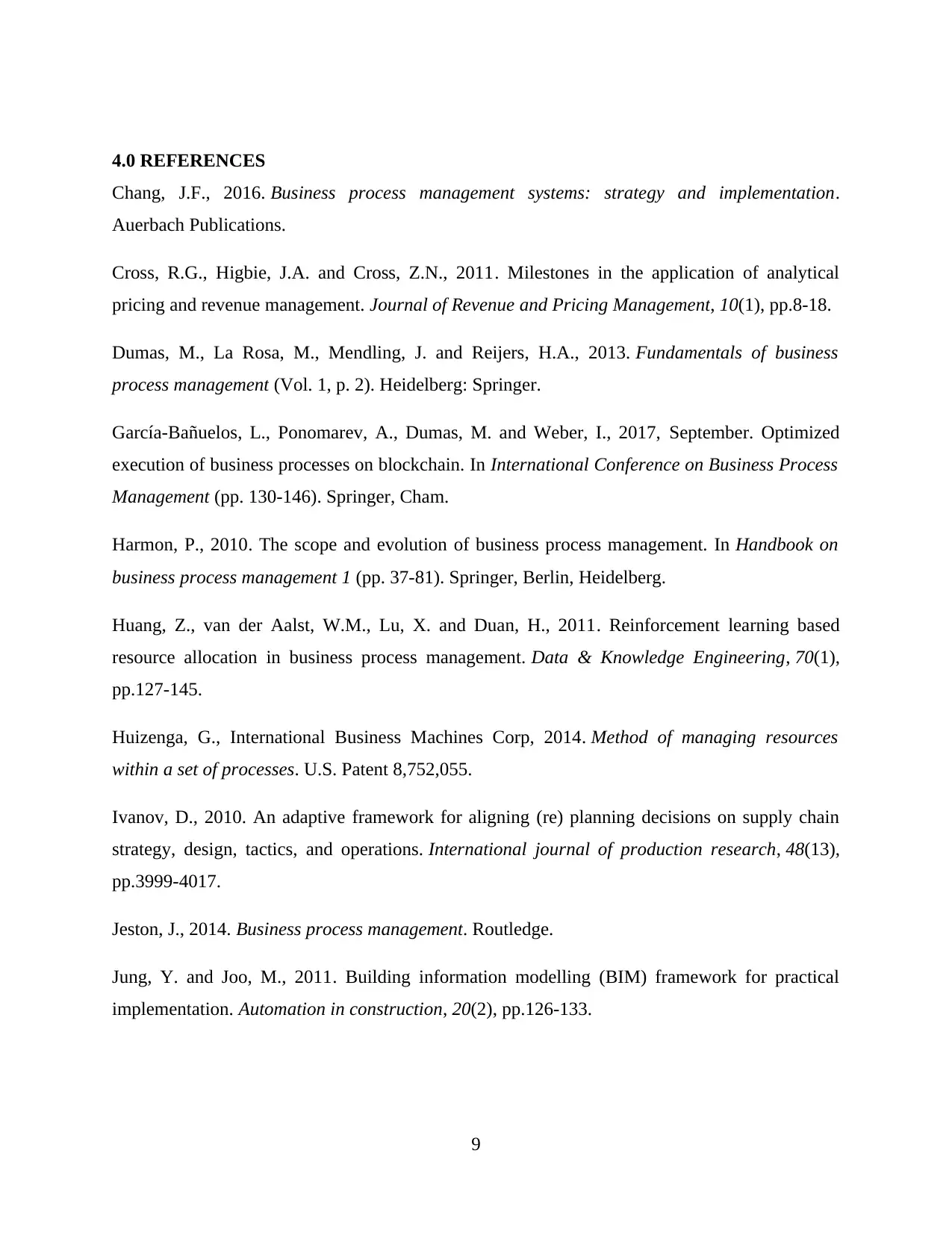
4.0 REFERENCES
Chang, J.F., 2016. Business process management systems: strategy and implementation.
Auerbach Publications.
Cross, R.G., Higbie, J.A. and Cross, Z.N., 2011. Milestones in the application of analytical
pricing and revenue management. Journal of Revenue and Pricing Management, 10(1), pp.8-18.
Dumas, M., La Rosa, M., Mendling, J. and Reijers, H.A., 2013. Fundamentals of business
process management (Vol. 1, p. 2). Heidelberg: Springer.
García-Bañuelos, L., Ponomarev, A., Dumas, M. and Weber, I., 2017, September. Optimized
execution of business processes on blockchain. In International Conference on Business Process
Management (pp. 130-146). Springer, Cham.
Harmon, P., 2010. The scope and evolution of business process management. In Handbook on
business process management 1 (pp. 37-81). Springer, Berlin, Heidelberg.
Huang, Z., van der Aalst, W.M., Lu, X. and Duan, H., 2011. Reinforcement learning based
resource allocation in business process management. Data & Knowledge Engineering, 70(1),
pp.127-145.
Huizenga, G., International Business Machines Corp, 2014. Method of managing resources
within a set of processes. U.S. Patent 8,752,055.
Ivanov, D., 2010. An adaptive framework for aligning (re) planning decisions on supply chain
strategy, design, tactics, and operations. International journal of production research, 48(13),
pp.3999-4017.
Jeston, J., 2014. Business process management. Routledge.
Jung, Y. and Joo, M., 2011. Building information modelling (BIM) framework for practical
implementation. Automation in construction, 20(2), pp.126-133.
9
Chang, J.F., 2016. Business process management systems: strategy and implementation.
Auerbach Publications.
Cross, R.G., Higbie, J.A. and Cross, Z.N., 2011. Milestones in the application of analytical
pricing and revenue management. Journal of Revenue and Pricing Management, 10(1), pp.8-18.
Dumas, M., La Rosa, M., Mendling, J. and Reijers, H.A., 2013. Fundamentals of business
process management (Vol. 1, p. 2). Heidelberg: Springer.
García-Bañuelos, L., Ponomarev, A., Dumas, M. and Weber, I., 2017, September. Optimized
execution of business processes on blockchain. In International Conference on Business Process
Management (pp. 130-146). Springer, Cham.
Harmon, P., 2010. The scope and evolution of business process management. In Handbook on
business process management 1 (pp. 37-81). Springer, Berlin, Heidelberg.
Huang, Z., van der Aalst, W.M., Lu, X. and Duan, H., 2011. Reinforcement learning based
resource allocation in business process management. Data & Knowledge Engineering, 70(1),
pp.127-145.
Huizenga, G., International Business Machines Corp, 2014. Method of managing resources
within a set of processes. U.S. Patent 8,752,055.
Ivanov, D., 2010. An adaptive framework for aligning (re) planning decisions on supply chain
strategy, design, tactics, and operations. International journal of production research, 48(13),
pp.3999-4017.
Jeston, J., 2014. Business process management. Routledge.
Jung, Y. and Joo, M., 2011. Building information modelling (BIM) framework for practical
implementation. Automation in construction, 20(2), pp.126-133.
9
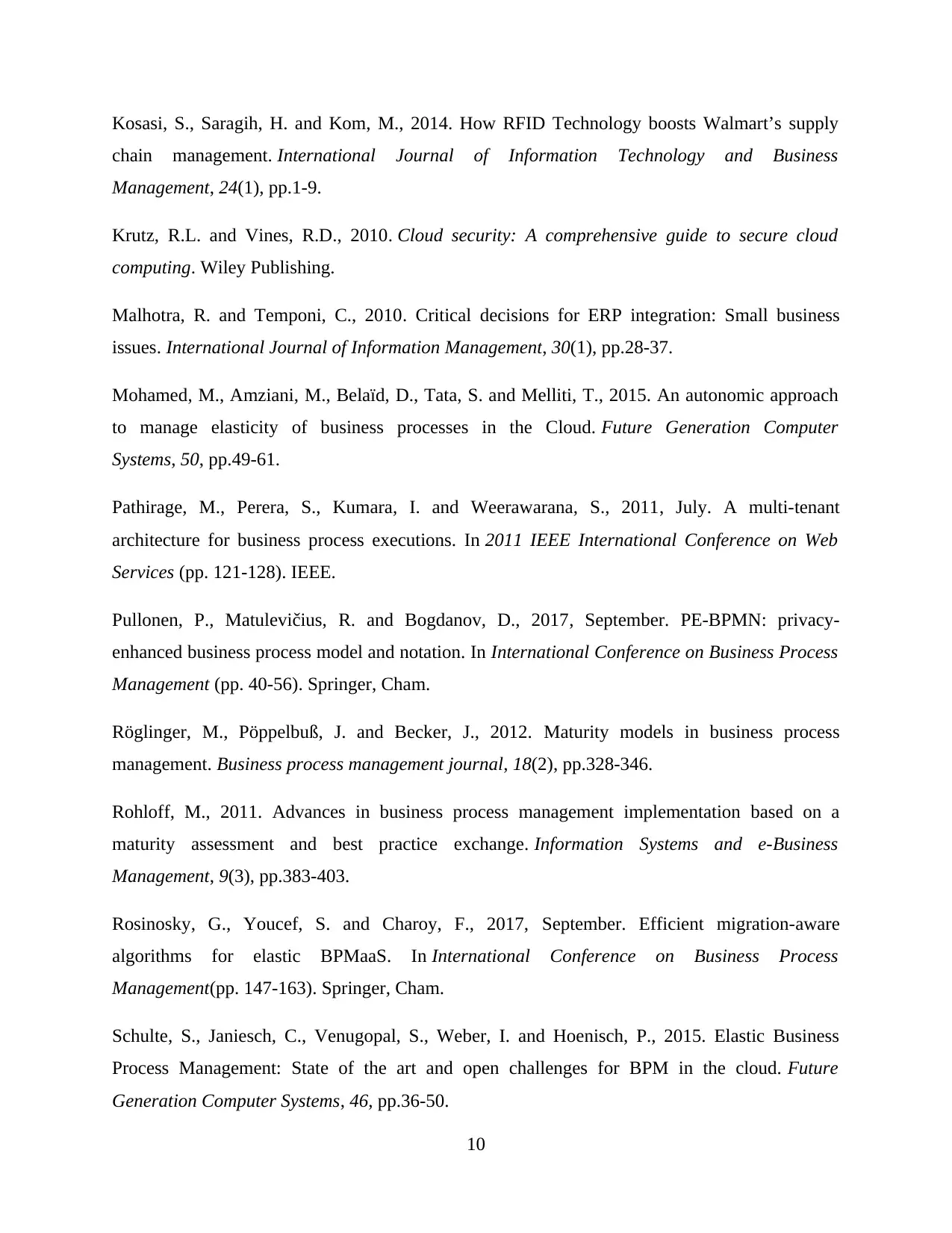
Kosasi, S., Saragih, H. and Kom, M., 2014. How RFID Technology boosts Walmart’s supply
chain management. International Journal of Information Technology and Business
Management, 24(1), pp.1-9.
Krutz, R.L. and Vines, R.D., 2010. Cloud security: A comprehensive guide to secure cloud
computing. Wiley Publishing.
Malhotra, R. and Temponi, C., 2010. Critical decisions for ERP integration: Small business
issues. International Journal of Information Management, 30(1), pp.28-37.
Mohamed, M., Amziani, M., Belaïd, D., Tata, S. and Melliti, T., 2015. An autonomic approach
to manage elasticity of business processes in the Cloud. Future Generation Computer
Systems, 50, pp.49-61.
Pathirage, M., Perera, S., Kumara, I. and Weerawarana, S., 2011, July. A multi-tenant
architecture for business process executions. In 2011 IEEE International Conference on Web
Services (pp. 121-128). IEEE.
Pullonen, P., Matulevičius, R. and Bogdanov, D., 2017, September. PE-BPMN: privacy-
enhanced business process model and notation. In International Conference on Business Process
Management (pp. 40-56). Springer, Cham.
Röglinger, M., Pöppelbuß, J. and Becker, J., 2012. Maturity models in business process
management. Business process management journal, 18(2), pp.328-346.
Rohloff, M., 2011. Advances in business process management implementation based on a
maturity assessment and best practice exchange. Information Systems and e-Business
Management, 9(3), pp.383-403.
Rosinosky, G., Youcef, S. and Charoy, F., 2017, September. Efficient migration-aware
algorithms for elastic BPMaaS. In International Conference on Business Process
Management(pp. 147-163). Springer, Cham.
Schulte, S., Janiesch, C., Venugopal, S., Weber, I. and Hoenisch, P., 2015. Elastic Business
Process Management: State of the art and open challenges for BPM in the cloud. Future
Generation Computer Systems, 46, pp.36-50.
10
chain management. International Journal of Information Technology and Business
Management, 24(1), pp.1-9.
Krutz, R.L. and Vines, R.D., 2010. Cloud security: A comprehensive guide to secure cloud
computing. Wiley Publishing.
Malhotra, R. and Temponi, C., 2010. Critical decisions for ERP integration: Small business
issues. International Journal of Information Management, 30(1), pp.28-37.
Mohamed, M., Amziani, M., Belaïd, D., Tata, S. and Melliti, T., 2015. An autonomic approach
to manage elasticity of business processes in the Cloud. Future Generation Computer
Systems, 50, pp.49-61.
Pathirage, M., Perera, S., Kumara, I. and Weerawarana, S., 2011, July. A multi-tenant
architecture for business process executions. In 2011 IEEE International Conference on Web
Services (pp. 121-128). IEEE.
Pullonen, P., Matulevičius, R. and Bogdanov, D., 2017, September. PE-BPMN: privacy-
enhanced business process model and notation. In International Conference on Business Process
Management (pp. 40-56). Springer, Cham.
Röglinger, M., Pöppelbuß, J. and Becker, J., 2012. Maturity models in business process
management. Business process management journal, 18(2), pp.328-346.
Rohloff, M., 2011. Advances in business process management implementation based on a
maturity assessment and best practice exchange. Information Systems and e-Business
Management, 9(3), pp.383-403.
Rosinosky, G., Youcef, S. and Charoy, F., 2017, September. Efficient migration-aware
algorithms for elastic BPMaaS. In International Conference on Business Process
Management(pp. 147-163). Springer, Cham.
Schulte, S., Janiesch, C., Venugopal, S., Weber, I. and Hoenisch, P., 2015. Elastic Business
Process Management: State of the art and open challenges for BPM in the cloud. Future
Generation Computer Systems, 46, pp.36-50.
10
⊘ This is a preview!⊘
Do you want full access?
Subscribe today to unlock all pages.

Trusted by 1+ million students worldwide
1 out of 13
Related Documents
Your All-in-One AI-Powered Toolkit for Academic Success.
+13062052269
info@desklib.com
Available 24*7 on WhatsApp / Email
![[object Object]](/_next/static/media/star-bottom.7253800d.svg)
Unlock your academic potential
Copyright © 2020–2025 A2Z Services. All Rights Reserved. Developed and managed by ZUCOL.





